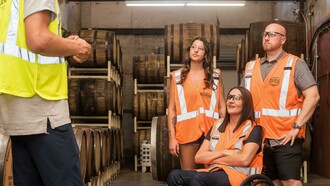Agriculture accounts for between a quarter and a third of all greenhouse emissions. The higher estimate includes everything from deforestation and transport to emissions from synthetic fertilisers and food waste. At the very least, a quarter of human emissions are produced from producing the food we – and our animals – eat. Our animals, particularly cattle, are a large producer of methane – one of the most potent greenhouse gases. Though there are no silver bullets in reducing these emissions, there are some promising solutions. One of these is seaweed.
Methane, as anyone in school learns, is far more potent than carbon dioxide. Globally, livestock animals produce around 40 per cent of methane emissions, with much of this coming from cattle. Livestock production alone - primarily cows - produce 14.5 per cent of global greenhouse gas emissions. Cows are ruminants, a group of mammals that get their nutrients from plants by fermenting them in a specialised stomach filled with microbes before digestion. In digesting their high-fibre diet, cows emit this methane as a by-product.
The problem becomes more apparent when one takes a look at the numbers involved. A single cow produces between 69 to 120 kilograms of methane gas per year. The U.S. Department of Agriculture estimates the global cattle population to be around 940 million (in 2022), which would produce between 64 and 112 million tonnes of methane into the atmosphere every year.
Most people would assume that cow farts are to blame for all these emissions. But that’s not the case at all. The majority of the methane is instead belched (burped) out throught the cow’s nostril or mouth. In the words of one researcher: “we don’t care about the back end”. But there appears to be a solution – or at least the start of one. In 2016, Australian researchers published a paper which showed the results of their testing with a species of red algae – the thousands of different seaweed types are divided into green, red and brown seaweeds – called Asparagopsis taxiformis. It grows off the coast of the eastern Australian state of Queensland.
They found that a dose of less than two per cent of total feed weight per day reduced methane production by more than 99 per cent in the lab. Upon digestion, Asparagopsis produces a compound called Bromoform (CHBR3) that halts the production of methane in the stomach of ruminants.
Some countries have already made attempts to use feed additives to reduce emissions. The Nordic country of Sweden has already approved a feed made with 3-NOP. 3-NOP (3-Nitrooxypropanol) is a synthetic compound that is not naturally occurring. It is produced through chemical synthesis in a laboratory rather than being extracted from a natural source. It was approved in February of 2022 for dairy cattle throughout the European Union and, according to Swedish reports, can reduce methane emissions from dairy cows by about 30%, and by 45% for meat cattle.
Naturally occurring seaweed provides much more promising results. While Swedish researchers have acknowledged the 90-percent reductions in methane, they say that more knowledge on cultivation and use is needed. There are also gaps in scientific knowledge about the long-term effects that seaweed in the diet will cause. Despite the caution, there are calls for more research and analysis.
And not much of it is needed for each cow. Research from the University of California at Davis found that adding 85 grams of seaweed per day to animal feed reduced methane emissions by 82 percent. One trial showed a 60 percent reduction in methane emissions by using just 1 percent of seaweed in the diet.
Researchers are investigating other types of aquaculture products that could be used in cattle feed, but so far the red seaweed Asparagopsis taxiformis shows the most promise. Another Australian red seaweed called Asparagopsis armata is under investigation. It is invasive in the Mediterranean Sea and has spread to the Northeastern Atlantic Ocean as well. In trials with dairy cows, it has reduced emissions by 67 percent with a 1 percent feed mix. Were seaweed feeds to be introduced as scale, the problem would be scaling up production.
Can enough seaweed be grown to feed all the world’s cattle? As a reminder, the USDA estimates that there were around 940 million head of cattle in the world in 2022. In the U.S. there are around 3 times as many beef cows as dairy cows. It’s difficult to say how much the average cow needs to survive – different breeds with different purposes (dairy or meat) require different feeds – but a cow requires about 2 percent of its body weight in feed per day. With very back-of-the-envelope calculations using an ‘average’ beef cow weighing 630 kilograms, that’s 12 kilograms of food per day. We arrive at a total of 120 grams of seaweed per cow per day. 112 million kg of seaweed per day. 41 million tonnes a year. Total seaweed production in 2019 was just under 39 million tonnes.
That does sound hopeful, but that is 39 million tonnes of WET seaweed. When you dry it, you get far less – about 12 percent of the wet weight. So we can assume that global dry production of seaweed was at least 4.68 million tonnes in 2019 – it is likely over 5 million tonnes in 2023. However, this is a mix of red, green and brown algae. Red algae are usually on the smaller side – more ocean surface area is needed to grow them compared to green and brown algae. On the other hand, they fetch much higher prices because of the nutrients they contain.
As long as a seaweed farmer can expect to make a profit growing seaweed, there’s no reason to believe that we are not able to meet this goal by, let’s say, 2050 if we look at current market growth rates of above 10 percent a year. While this sounds like an incredibly promising climate solution that may help us deliver sustainable protein and dairy sources while feeding the world’s growing population, we have to remember that there are no silver bullets. Governments, companies, and individuals should be investing more than ever in research and development to solve the myriad issues that we are the cause of.















